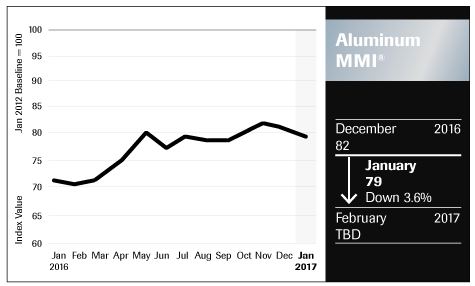After surging in November, base metals fell across the board in December. That selling pressure spread into aluminum markets, limiting any upside moves into the year-end. Prices however didn’t give that much ground as aluminum’s fundamental story remains rather bullish. The drops look a lot like classic profit-taking.
The auto industry is a key driver of aluminum demand. Auto sales in US and China (the world’s biggest car market) finished the year on a strong note. Total vehicle sales in the U.S. hit an 11-year high in December, aided by a fourth-quarter surge in demand that exceeded expectations. In China, car sales hit an all-time record in November, up 17.1% year-on-year.

Although the figures came in strong, they should be taken with a pinch of salt. In the U.S., cars were sold at an average 10% discount off the original asking price and that’s an incentive level not seen since the beginning of the financial crisis. Similarly, in Q4, China announced a 50% cut in its sales tax on automobiles with small engines. The tax cut was effective only until the end of 2016 although some analysts expect China to extend the tax cut into next year.
Chinese Supply
One of the factors supporting higher aluminum prices has been that there were fewer smelter restarts than expected smelter in China. In addition, we foresee limited additional restarts this year due to rising production costs and pollution issues in China.
First, alumina seems headed for a supply deficit this year following Chinese curtailments. Second, coal prices have surged since China reduced the hours for workers in its coal sector, supposedly in a bid to control pollution and curtail its excess industrial capacity. Truth be told, though, China really relaxed the mining day norm simply to control skyrocketing — some would say artificially high — prices. However, we expect the maneuvers will keep China’s supply of coal and aluminum in check this year.
For years, China’s cities have been choking on the smog spewing from China’s industrial production sector but things have recently gotten much worse. Two weeks ago, authorities asked 23 cities in northern China to issue red alerts as inspection teams scoured the country. The scale of the red alert measure shows that the Chinese government is taking air pollution seriously. Given that coal burning is the biggest contributor to air pollution in China, industrial metals supply could shrink this year, particularly steel and aluminum.
What This Means For Metal Buyers
The massive existing overcapacity and questions regarding China’s ability to maintain its rate of growth are the main factors that could spoil the party for aluminum bulls. However, for the reasons explained above, it seems early to make a call on that. We still see upside potential in aluminum prices.
by Raul de Frutos
